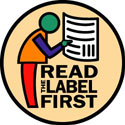Pesticide Safety: The Label is the Law
 To government agencies like the EPA, the pesticide label is a way to control the distribution, storage, sale, use, and disposal of the product. To the manufacturer, the label provides the required clearances so that the product can be sold. To the buyer or user, the label should be considered as the main source of information on how to use the product correctly, legally, and safely.
To government agencies like the EPA, the pesticide label is a way to control the distribution, storage, sale, use, and disposal of the product. To the manufacturer, the label provides the required clearances so that the product can be sold. To the buyer or user, the label should be considered as the main source of information on how to use the product correctly, legally, and safely.
You should read the pesticide label:
- Before purchasing the pesticide to ensure that it is the correct one for the job
- Before mixing the pesticide to ensure the proper pesticide concentrations
- Before applying the pesticide to ensure proper use
- Before storing excess chemical or disposing of an empty pesticide container
As the saying goes, "The Label is the Law." The first step in using a pesticide safely is to read the product label to learn how the product may legally be used. The label will provide a range of information that typically falls into four major categories: safety, environmental, product, and use.
Information may include but is not limited to:
- Active ingredient(s) in the pesticide
- Pest(s) that the product may be used on
- Site(s) where the product may be used (lawn, vegetable garden, etc.)
- Mixing instructions, if the product is not a ready-to-use product
- Protective equipment required for application
- Application method(s) that are required or preferred, as well as those that are prohibited
- Amount of total pesticide that should be applied
- Rate of application
- Frequency of application
- Restrictions (if any) on product use including weather, time of day, season of year, contamination of sensitive areas, exposure of non-target species, etc.
- Restricted entry intervals (REIs) following an application
- Preharvest intervals for products that can be used on edible crops
- Storage and disposal requirements and limitations
- Other requirements as necessary
Every pesticide label will also carry information about the product’s potential acute toxicity. Since all pesticides are poisons to some degree, it is important to be aware that they do pose some risk. The label may include signal words such as DANGER, WARNING, or CAUTION which indicate how acutely toxic the product is to humans.
Pesticides can enter the human body through the mouth, skin, lungs, and eyes. Anyone who applies pesticides should take the appropriate precautions as described on the label, including wearing any required protective gear. In addition to following label guidelines, anyone working with pesticides should take these steps to protect people and pets:
- Remove toys before application
- Remove or cover pet food and water dishes
- Never place rodent baits where children, pets, or wildlife will come in contact with them
- Store pesticides in their original containers out of the reach of children

